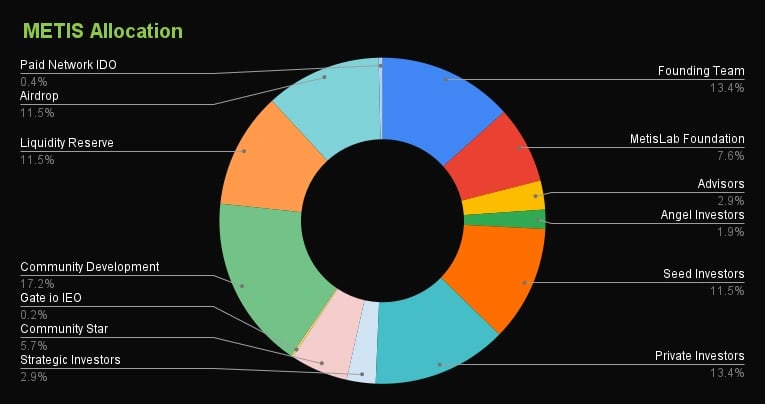위키 구독하기
Share wiki
Bookmark
Metis
Metis
Metis(메티스)는 빠르고 간편한 스마트 계약 배포를 위해 설계된 Ethereum Layer 2 Rollup 플랫폼입니다. 이 플랫폼은 트랜잭션 속도, 비용 및 확장성과 같이 Ethereum mainnet에서 발생하는 문제들을 해결하기 위한 여러 가지 솔루션을 제공합니다. [1]
Elena Sinelnikova(엘레나 시넬니코바), Yuan Su(위안 수), 그리고 Kevin Liu(케빈 리우)는 Metis의 공동 설립자입니다.
개요
메티스(Metis)는 개발자, DAO(탈중앙화 자율 조직), 사용자를 위해 설계된 다양한 제품을 제공하는 이더리움 레이어 2 솔루션입니다. 이러한 제품에는 NFT(대체불가토큰) 브리지, 테스트넷, 그래프 및 메티스 노드와 같은 기능이 포함되며, 이 모든 것이 단일 플랫폼에 통합되어 있습니다. 이 프로토콜은 Dapp(탈중앙화 애플리케이션) 개발자와 Web3 애호가들이 이더리움 레이어 2 개발을 이해하고 고급 블록체인 기술을 활용하는 데 도움을 주는 것을 목표로 합니다. 메티스는 이더리움 애플리케이션 및 Dapp 개발자를 위한 레이어 2 확장 프로토콜로서, Web3 생태계의 발전을 지원하기 위해 더 빠르고 비용 효율적인 트랜잭션에 중점을 둡니다. Web3 지지자 및 숙련된 개발자를 포함한 많은 사용자가 이용할 수 있으며 다양한 프로젝트에 통합될 수 있습니다. [2]
기술
메티스 가상 머신 (MVM, Metis Virtual Machine)
메티스는 낙관적 롤업(https://iq.wiki/wiki/optimistic-rollup)과 동등한 기능을 가진 EVM(이더리움 가상 머신)인 메티스 가상 머신(MVM)을 롤업 솔루션에 통합합니다. MVM은 EVM과 매우 유사하지만 컴퓨팅 및 스토리지 기능 분리와 같은 향상된 기능을 제공합니다. 이러한 설계 덕분에 기존 이더리움 dApp을 메티스로 쉽게 마이그레이션할 수 있으며, 다른 낙관적 롤업에 비해 가스 수수료가 낮고 출금 시간이 더 빠릅니다. 이더리움의 소셜 그래프를 활용하여 메티스는 EVM 체인 전반에서 일관된 주소를 보장하여 새로운 프로젝트가 사용자/주소 메타데이터를 활용하여 콜드 스타트 문제를 해결하는 데 도움이 됩니다. [3]
EVM과 거의 동일하지만, MVM은 OR 설계 및 사기 증명 프로세스를 용이하게 하는 특정 계약으로 구성됩니다. 예를 들어, MVM_Verifier 계약은 사기 증명 검증을 관리하며, 사기 증명의 유효성 검사 시 상태 커밋 체인에서 특정 상태 배치를 제거합니다. EVM의 광범위한 채택에도 불구하고, 동적 특성으로 인해 롤업에 어려움이 있으며, ZKFP와 같은 사기 증명 시스템의 안정성을 저해할 수 있는 지속적인 업그레이드가 필요합니다. [3]
하이브리드 롤업
2023년 3월, Metis는 Optimistic Rollup의 확장성과 Zero-Knowledge Rollups' 보안 및 빠른 최종성을 결합한 Hybrid Rollup(하이브리드 롤업) 개발을 발표했습니다. 이를 통해 이더리움 개발자는 탈중앙화 애플리케이션을 배포할 수 있는 안전한 Layer 2 솔루션을 확보하게 되었습니다. [4]
하이브리드 롤업을 개발하기로 결정한 것은 낙관적 및 제로지식 아키텍처의 장점을 결합하여 사용자 경험을 향상시키고자 하는 열망에서 비롯되었습니다. Optimistic Rollup은 확장성을 제공하지만 제한이 있으며, 제로지식 롤업 또한 마찬가지입니다. Metis는 이 두 가지 접근 방식을 통합하여 개발자에게 사용하기 쉬운 코딩 환경을 제공하는 동시에 사용자의 최종성, 보안 및 탈중앙화를 보장하고자 했습니다. [4]
하이브리드 롤업 방식은 두 가지 모두의 장점을 제공하는 것을 목표로 하며, 사용자와 개발자 경험을 우선시했습니다. Optimistic Rollup의 아키텍처를 활용하여 코딩을 더욱 쉽게 하고 Zero-Knowledge Rollup의 보안 및 최종성을 활용함으로써 Metis는 Web3의 DeFi에서 요구하는 증가하는 보안 표준을 충족하고자 했습니다. [4]
Polis
Polis는 분산 자율 회사(DAC) 관리를 위한 미들웨어 프로그램으로, DApps의 Metis 2계층으로의 전환을 간소화합니다. 개발자는 전문적인 블록체인 코딩 기술 없이도 DApps/DAC를 생성할 수 있습니다. Polis는 METIS 코인 스테이킹을 위한 지갑 클라이언트를 포함하여 DApps와의 사용자 상호 작용을 용이하게 합니다. 또한 Polis는 Ethereum Naming Service (ENS)의 대안으로 스마트 계약 도메인 서비스를 제공합니다. 이 미들웨어 프로토콜은 도메인 업데이트를 지원하고, 도메인을 기반으로 스마트 계약이 메서드를 실행할 수 있도록 하며, 마켓플레이스에서 도메인 거래를 용이하게 합니다. [5][6]
신원 관리는 탈중앙화 애플리케이션 채택에 있어 중요한 과제입니다. 이를 해결하기 위해 Polis는 상위 수준의 미들웨어 애플리케이션 관리자를 제공하여 인증 서비스를 제공합니다. 이 서비스는 앱 개발자가 지갑을 통합하지 않고도 사용자 액세스를 관리하는 데 도움이 됩니다. 기존 인증 방법을 활용하여 Polis 미들웨어를 통해 개발자는 암호화 키 관리 없이도 사용자를 원활하게 온보딩할 수 있습니다. [5][6]
METIS 토큰 (METIS Token)
METIS는 Metis 암호화폐 생태계 내에서 여러 기능을 수행하는 ERC-20 토큰입니다. 주로 Metis의 2계층 솔루션에서 중요한 역할을 합니다. METIS 토큰은 Rangers로 알려진 행위자들에 의해 스테이킹되어 Metis가 트랜잭션을 번들로 묶어 Andromeda 네트워크로 처리를 위해 보낼 때 트랜잭션을 검증하는 데 사용됩니다. 이러한 Rangers는 트랜잭션의 유효성과 진정성을 보장하는 책임이 있으며, 악의적인 행위에 가담할 경우 스테이킹된 METIS 토큰이 페널티로 삭감될 수 있습니다. [7]
또한, METIS 토큰은 Metis Andromeda 네트워크에서 트랜잭션 수수료를 지불하는 데 사용되며, 사용자는 METIS 토큰을 스테이킹하여 보상을 받을 수도 있습니다. Metis는 'Builder Mining' 프로그램을 운영하여 Andromeda 네트워크에서 실행하는 각 트랜잭션에 대해 METIS 암호화폐 보상으로 회원 DAC를 인센티브화합니다. [7]
토큰 경제학
토큰의 최대 공급량은 10,000,000개로 지정되어 있습니다. 2021년, METIS 토큰의 전체 평생 공급량의 초기 49.3%가 콜드 런치, 팀, 자문위원, 투자자 및 생태계/커뮤니티 개발을 위해 생성 및 할당되었습니다. 나머지 토큰은 다음과 같이 할당되었습니다: [8]

- 설립 팀에 7.00% 할당
- MetisLab 재단에 4.00% 할당
- 자문위원에 1.50% 할당
- 엔젤 투자자에 1.00% 할당
- 커뮤니티 스타에 3.00% 할당
- Gate io IEO에 0.10% 할당
- 커뮤니티 개발에 9.00% 할당
- 유동성 준비금에 6.00% 할당
- 에어드롭에 6.00% 할당
- 유료 네트워크 IDO에 0.20% 할당
메티스 DAC (Metis DAC)
메티스는 일반적인 탈중앙화 자율 조직(DAO) 방식에서 벗어나 탈중앙화 자율 기업(DAC) 모델을 통한 커뮤니티 기반 거버넌스를 우선시합니다. [9]
DAO에서는 참여자의 토큰 보유량에 따라 의사결정이 이루어지므로, 대규모 토큰 보유자의 지배와 무분별한 투표로 이어질 수 있습니다. 그러나 메티스는 DAC 모델을 통해 이러한 문제를 해결합니다. DAC 거버넌스 규칙은 스마트 계약을 통해 설정되며, 실제 기업 구조를 모방합니다. 이러한 프레임워크는 특정 사용자 그룹에 특정 투표권을 할당하는 맞춤형 거버넌스를 가능하게 합니다. [9]
DAC 모델 내에는 두 가지 주요 행위자, 즉 공통체(Commons)와 에코노드(EcoNodes)가 있습니다. 공통체는 METIS 토큰을 제안하고 스테이킹하여 veMETIS 거버넌스 토큰을 획득하여 의사결정권을 얻을 수 있습니다. 기여도에 따라 기존 에코노드 중에서 선정된 에코노드는 더 큰 투표권을 갖습니다. [9]
파트너십
OpenDeFi
2020년 6월, Metis는 탈중앙화 금융 프로젝트인 OpenDeFi와의 파트너십을 발표했습니다. 분산된 협업자들을 위한 2계층 인프라인 Metis는 개인이 이더리움 블록체인에서 탈중앙화된 비즈니스를 구축할 수 있도록 했습니다. Metis의 2계층 dApp 솔루션을 통해 이 프로세스가 더욱 신속하고 비용 효율적이며 확장 가능해졌습니다. 이 파트너십을 통해 OpenDeFi 자산을 Metis의 2계층 인프라에서 활용할 수 있게 되어 개발자는 보관 중인 실제 자산을 보험에 가입하여 dApp을 구축할 수 있게 되었습니다. [10]
“OpenDeFi는 기관 투자자를 DeFi에 유치하는 데 중점을 두고 장기적인 관점에서 구축하고 있으며, Metis는 이러한 미래를 함께 구축하게 되어 기쁩니다…고품질 DeFi 파트너를 확보하고 Metis의 2계층 플랫폼에 온보딩하면 Metis와 OpenDeFi와 같은 놀라운 파트너가 미래의 경제를 강화하는 데 도움이 될 것입니다.” - Metis의 공동 설립자이자 CEO인 Elena Sinelnikova.
PAID 네트워크(PAID Network)
2020년 6월, 메티스(Metis)는 아폴로-X(Apollo-X) 및 이그니션(Ignition) 런치패드 플랫폼 운영자인 PAID 네트워크와 파트너십을 발표했습니다. 이 협력을 통해 PAID 개발팀은 메티스의 2계층 인프라 위에 아폴로-X 및 이그니션 런치패드를 구축할 수 있었습니다. 그 결과, 메티스의 사용자 친화적인 롤업(Rollup) 구조 덕분에 가스 수수료가 낮아지고, 트랜잭션 속도가 빨라지고, 확장성이 향상되었습니다. [11]
탈중앙화된 이더리움 블록체인 기반으로 구축된 메티스(Metis)는 중앙화된 사이드체인에서는 찾아볼 수 없는 최고 수준의 보안을 PAID 네트워크에 제공했습니다. 메티스 2계층 솔루션을 채택함으로써 아폴로-X와 이그니션은 트랜잭션 비용이 1센트 미만이고 완료 시간이 1초 미만인 블록체인 생태계를 활용할 수 있었습니다. [11]
“메티스와의 파트너십은 아폴로-X와 이그니션 런치패드 플랫폼과 각 커뮤니티 모두에게 소중한 발판이 됩니다. 메티스 롤업(Metis Rollup)이라고 불리는 메티스의 2계층 솔루션은 dApp 구축 및 운영 비용을 훨씬 저렴하고 효율적으로 만들어주는 동시에 이더리움 단독으로 제공할 수 있는 것보다 훨씬 더 큰 확장성과 높은 수준의 기능을 제공합니다. 메티스의 2계층 솔루션을 통해 아폴로-X와 이그니션을 더욱 확장하고 양쪽 커뮤니티 모두에게 더욱 비용 효율적이고 효과적인 사용자 경험을 제공할 수 있을 것입니다.” - Kyle Chasse, PAID 네트워크 CEO
Parsiq (파시크)
메티스는 6월 15일 베타 테스트넷 출시 전 블록체인 모니터링 및 워크플로 자동화 플랫폼인 PARSIQ와 전략적 파트너십을 발표했습니다. PARSIQ는 블록체인과 오프체인 애플리케이션 간의 가교 역할을 합니다. 이 파트너십을 통해 PARSIQ는 CasperLabs 및 Findora와 함께 메티스의 기술 및 인프라 파트너로 자리매김하게 되었습니다. Bagels Finance, OpenDeFi, Asteria 및 Rozoj를 포함한 PARSIQ의 DeFi 중심 파트너는 Metis Layer 2 통합의 혜택을 누리게 될 것입니다. [12]
이 통합을 통해 PARSIQ의 데이터 스트림 처리 서비스를 통해 Metis Layer 2 에코시스템 내에서 실시간 거래 데이터 및 모니터링이 가능해집니다. 이러한 개선은 시장 활동 분석 및 보안 기능 향상을 추구하는 DeFi 프로젝트에 도움이 됩니다. [12]
반대로, PARSIQ가 지원하는 프로젝트는 Ethereum Layer 1과 비교하여 Metis Layer 2 롤업이 제공하는 속도, 기능, 확장성 및 사용 편의성을 활용할 수 있습니다. 또한 메티스는 가스 수수료를 크게 줄여 이더리움에서 전환하는 프로젝트의 거래 비용을 더욱 효율적으로 만듭니다. [12]
“이더리움 네트워크의 잠재력을 높이 평가하지만, 성장과 개선의 여지가 분명히 있습니다. 메티스가 추진하는 이더리움 생태계 개선과 광범위한 코딩 지식 없이도 실제로 사용할 수 있는 도구를 만드는 노력은 우리에게 공감을 줍니다. 이것은 실제 사람들을 위해 실질적인 일을 하고 사용자와 그들이 속한 생태계 모두를 위해 더 나은 환경을 조성하는 진정한 프로젝트입니다.” - Tom Tirman, Parsiq CEO
Ethena
2024년 2월 28일, Metis는 Ethena와의 전략적 파트너십을 발표했습니다. 이 파트너십은 "합성 화폐"와 같은 수익 창출 자산에 대한 관심이 증가하고 있으며, 이는 상당한 성장 가능성을 가지고 있음을 반영합니다. Metis는 고품질 수익률을 제공하고 화폐 및 관련 트레이드오프에 대한 인식을 바꾸는 데 Ethena를 지원하는 것을 목표로 합니다. [13]
Metis와 Ethena 간의 제휴는 DeFi 전략을 강화하고자 합니다. L2 솔루션으로 잘 알려진 Metis는 Ethena에 강력한 네트워크를 제공하여 USDe의 채택을 가속화하고 사용 사례를 확장합니다. 이 협력의 일환으로 USDe는 Ethena의 Shards 캠페인과 함께 Metis 플랫폼에 도입되어 사용자에게 다양한 통합 및 기회를 제공합니다. [13]
최근 전개 상황
시퀀서 마이닝 출시
2024년 4월, 메티스(Metis)는 탈중앙화 시퀀서 업그레이드 2단계의 일환으로 탈중앙화 시퀀서 마이닝 시스템을 도입했습니다. 이 단계에는 시퀀서 마이닝, 트랜잭션 풀, 블록당 여러 트랜잭션 구현이 포함되어 네트워크 효율성과 탈중앙화를 향상시키는 것을 목표로 합니다.
트랜잭션의 순서를 정하고 배치하는 역할을 하는 시퀀서는 단일 장애 지점을 제거하여 네트워크 복원력 유지를 위해 중요한 역할을 합니다. 시퀀서 노드는 네트워크 운영에 대한 기여에 대해 METIS 토큰을 얻을 수 있으며, 유동적 스테이킹 제공자 (LST)는 사용자가 유동적 스테이킹 토큰과 교환하여 자산을 스테이킹할 수 있도록 합니다.
최초의 LST 제공자인 아르테미스 파이낸스(Artemis Finance)와 엔키 프로토콜(Enki Protocol)은 메티스 커뮤니티 에코시스템 거버넌스(CEG)에 의해 알파 단계에 참여하도록 선정되었습니다. 이 플랫폼은 또한 시퀀서 마이닝 참여를 장려하기 위해 첫 해에 20%의 마이닝 보상률(MRR)을 도입하여 탈중앙화 모델을 더욱 강화했습니다.[14]
공유 네트워크 소유권 및 거버넌스 (2024년 6월)
Metis는 외부 노드 운영자가 분산형 시퀀서 시스템에 참여할 수 있도록 허용함으로써 완전한 분산화를 위한 노력을 계속했습니다. 이러한 개발을 통해 중요한 인프라의 소유권이 분산형 시퀀서(dSeq) 노드 풀에 분산되어 네트워크 보안과 안정성이 향상됩니다. 노드 운영자는 거버넌스 권한과 시퀀싱 보상을 공유하여 네트워크의 전반적인 성장과 안정성에 그 성공을 묶습니다.
이 모델은 더 넓은 커뮤니티 참여를 촉진하고 중앙화된 시퀀서와 관련된 위험을 제거하는 것을 목표로 합니다. 외부 노드 운영자의 첫 번째 배치는 2024년 6월 커뮤니티 투표 과정을 통해 선정되었습니다.[15]
체인링크 CCIP 통합 (2024년 3월)
2024년 3월, 메티스는 크로스체인 기능을 향상시키기 위해 체인링크의 크로스체인 상호운용성 프로토콜(CCIP)을 통합했습니다. 초기에는 이더리움에서 메티스 네트워크로의 스테이블코인 전송에 중점을 두었습니다. 이 통합은 토큰 전송 시간을 단축하고 크로스체인 상호 작용을 위한 표준화된 인터페이스를 제공하는 것을 목표로 합니다.
체인링크와의 협업을 통해 프로그래밍 가능한 토큰 전송도 도입되어 사용자와 개발자 경험이 향상되고 탈중앙화 금융(DeFi) 및 기타 웹3 애플리케이션 전반에 걸친 메티스의 광범위한 채택을 위한 기반을 마련합니다.[16]
라우터 프로토콜 파트너십 (2024년 5월)
메티스는 2024년 5월 라우터 니트로 에코시스템의 일원이 되어 메티스와 다른 지원되는 블록체인 네트워크 간의 더 빠르고 비용 효율적인 자산 이전을 가능하게 했습니다. 이 파트너십을 통해 사용자는 여러 체인 간에 자산을 브리징할 수 있는 더 많은 옵션을 제공받아 확장 가능한 이더리움 레이어-2 솔루션으로서 메티스의 입지를 더욱 강화합니다.
이 통합을 통해 메티스는 사용자에게 더 낮은 거래 비용과 향상된 성능을 제공하여 이더리움을 Web3 개발자와 사용자에게 더욱 접근 가능하게 만든다는 목표에 기여합니다. [17]
잘못된 내용이 있나요?
